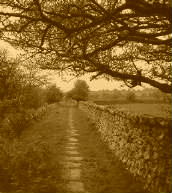
The Office Today
The
remains of the office in 2001 as seen from the footpath. The foundations
can be seen to the feft of a patch of undergrowth with a line of fence
post runnung infront. .None of these fence post existed in the Victorian
photograph indicating that these originate from the period when the LCR
remained open but the Mine was shut and the headhunt remained in use to
allow trains to reverse onto the Tokenbury branch.
Using
the hut as a reference point it can quickly be seen how much material
has been removed from the valley floor since South Caradon's closure. The
huge wall of rock had disappeared and undergrowth now grows over the ore
floors |
In
the view above a small office is prominent beside the railway track
at the head of the ore yard. The hut is dwarfed by the reveted piles of
waste rock behind it and a lone worker appears to be busy with a shovel
just outside its door. It has been assumed that the building was an office
associated with the ore transport and was possibly owned by the LCR rather
than the mine.
.
|
